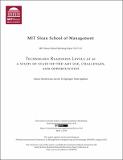Technology readiness levels at 40: A study of state-of-the-art use, challenges, and opportunities
Author(s)
Olechowski, Alison L; Joglekar, Nitindra; Eppinger, Steven D.
DownloadTechnology readiness levels.pdf (516.0Kb)
PUBLISHER_CC
Publisher with Creative Commons License
Creative Commons Attribution
Terms of use
Metadata
Show full item recordAbstract
The technology readiness level (TRL) scale was introduced by NASA in the 1970s as a tool for assessing the maturity of technologies during complex system development. TRL data have been used to make multi-million dollar technology management decisions in programs such as NASA's Mars Curiosity Rover. This scale is now a de facto standard used for technology assessment and oversight in many industries, from power systems to consumer electronics. Low TRLs have been associated with significantly reduced timeliness and increased costs across a portfolio of US Department of Defense programs. However, anecdotal evidence raises concerns about many of the practices related to TRLs. We study TRL implementations based on semi-structured interviews with employees from seven different organizations and examine documentation collected from industry standards and organizational guidelines related to technology development and demonstration. Our findings consist of 15 challenges observed in TRL implementations that fall into three different categories: system complexity, planning and review, and validity of assessment. We explore research opportunities for these challenges and posit that addressing these opportunities, either singly or in groups, could improve decision processes and performance outcomes in complex engineering projects.
Date issued
2015-09Department
Massachusetts Institute of Technology. Department of Mechanical Engineering; Massachusetts Institute of Technology. Institute for Data, Systems, and Society; Sloan School of ManagementJournal
2015 Portland International Conference on Management of Engineering and Technology (PICMET)
Publisher
Institute of Electrical and Electronics Engineers (IEEE)
Citation
Olechowski, Alison; Eppinger, Steven D. and Joglekar, Nitin. “Technology Readiness Levels at 40: A Study of State-of-the-Art Use, Challenges, and Opportunities.” 2015 Portland International Conference on Management of Engineering and Technology (PICMET), August 2-6 2015, Institute of Electrical and Electronics Engineers (IEEE), September 2015 © Institute of Electrical and Electronics Engineers (IEEE)
Version: Final published version
ISBN
978-1-8908-4331-1
978-1-8908-4332-8